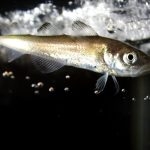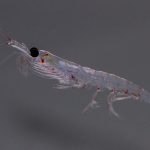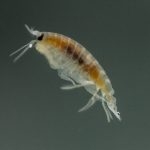






Welcome to the world beneath the ice.
We're all familiar with the animals that live above the ice at the
Arctic and Antarctica, but have you wondered about what goes on beneath
the ice?
I am not referring to those streamlined penguins zipping through the
water or a leopard seal barging into the scene and showing everyone
who's boss. I am talking about the other creatures and plants that
inhabit the mysterious world under the ice floes.
For millions of years, they had existed in ignominy, safe in the
freezing waters that are inhospitable to humans. But today, we are
steadily invading this strange world, as fishermen, adventurers and as
scientists. Thanks to technology, we are able to enter this world using
camera-toting underwater robots and specially designed nets that bring
up live specimens from the cold waters. Welcome to the world beneath the ice.
One of the main fish species in the Arctic Sea is the polar cod. In
2008, the stock was estimated to be 1.2 million tons. Today, the stock
is believed to be 1.5 to 2 million tons. Not bad for a fish that
measures just 25cm to 40cm.
In fact, when these fish are juvenile, they
measure no longer than our finger.
Of course, this makes them (and the polar cod larvae) very easy prey.
So, the youngsters resort to hiding in the cracks, caves and crevices
under the ice floes during this stage of their lives. Then, in their
third year of existence, these fish – millions of them – will move out
into the open seas as adult polar cod.
During their time under the ice floes, the juvenile polar cod feed on
the small organisms and algae that live on the underside of the ice
floe. And to describe some of these organisms as weird is an
understatement. A substantial number have gelatinous, semi-transparent
bodies, looking as if the artist had run out of paint when colouring in
the outlines. They are the amphipods, cocepods, krill, etc – some of
these organisms are actually sold as food for aquarium fish.
Their
sizes vary from a millimetre to a few centimetres long.
Sharing the same habitat are other organisms with exotic names like
salp, polychaete worms, polycheata, pteropod, etc. To us, they look
bizarre – and at the same time, fascinating and beautiful – as if they
are from another plane of existence. However, for the juvenile polar
cod and other marine creatures that feed on them, their presence simply
means a full tummy.
The foundation of the food web in both the Arctic and Antarctica is the
ice algae. This species of algae grows on the ice or on its underside,
and it can flourish with minimal light. Its growth is so rapid that 200
grammes of it can grow into one kilogramme in just four days. No wonder
then that ice algae are the vital foundation of the ecological food web
in the poles, being consumed by amphipods and copepods.
Next in line are the polar cod that chomp down on the amphipods and
copepods. They in turn become food for larger animals like seals,
penguins, whales and seabirds.
During summer, the food web continues. Although the ice area melts,
sunlight penetrates the upper levels of the ocean, prompting the growth
of algae, thus facilitating the continuation of the food web.
As AWI
sea ice ecologist Ilka Peeken said, “ After the long winter, these
algae are the first food source for animals in the under-ice community.”
As with so many other things, global warming has caused changes within
the environment beneath the ice. There has been intensive melting, and
the ice has grown thinner. In addition, isolated algal blooms have
become a common occurrence. They come about when meltwater pools on the
ice surface produce patches where light passes through the ice, leading
to ideal growth conditions for phytoplankton, which subsequently leads
to the algal blooms.
The excessive algae strands and clumps sink to the seafloor when the
ice melts, and becomes an additional food supply for the sea cucumbers
and brittle stars below. How this change in the “grand scheme of
things” would affect the ecology and ecosystem of the marine
environment is yet to be seen.
Indeed, these are exciting times for marine scientists.
As technology
advances even further, we are presented with boundless possibilities
that preceding generations could not have thought possible. The more we
learn about the world beneath the ice sheets, the more we realise that
there is so much more that is yet to be discovered.
In the words of AWI sea ice ecologists Peeken and Hauke Flores: “We're just getting started.”
 Mares
Mares 17th October 2016
17th October 2016